Tips From Sticks-In-The-Mud Woodshop
by Jim Randolph
Long Beach, Mississippi
Click on any picture to see a larger version.
Welcome to "Tips From Sticks-In-The-Mud Woodshop." I am a hobbyist, not a professional, someone who loves woodworking, just like you do. I have found some better ways to accomplish tasks in the workshop and look forward to sharing those with you each month, as well as hearing your problem-solving ideas.
Tip #1
Two-part epoxy has millions of uses. Years ago it came packaged with one tube of resin and one tube of hardener. For the last couple of decades manufacturers have put both parts into syringes locked side by side.
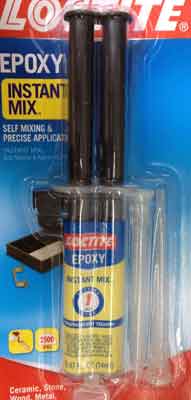
|
|
How two-part epoxy arrives in modern packaging.
|
However, as the ingredients get older it becomes increasingly difficult to advance the two syringe plungers in unison because the resin syringe requires more force than the hardener syringe. An easy solution to the problem: Using your band saw or a hack saw, carefully cut the plastic that joins the syringes, as well as the cap.
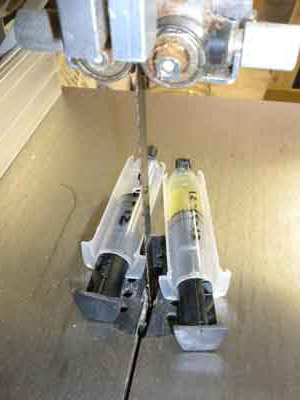
|
|
Saw slowly and carefully. I can’t even begin to imagine the mess that would gum up your band saw if you sliced into a tube!
|
Dispense the needed amount of each ingredient by eyeballing the size of the puddle. You can get the right amount of resin without pushing out too much hardener, making your glued project stronger and your two-part epoxy come out even. The divided cap will still index itself on each syringe for a tight fit.
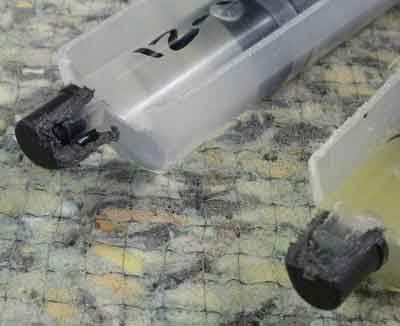
|
|
Caps still fit perfectly, meaning your two-part epoxy will last a long, long time.
|
Tip #2
No Southern-fried Southern boy wants to be called a Yankee, but we share the characteristics of shrewdness and thrift. Thus, each month we include a money-saving tip. It's OK if you call me "cheap."
In a veterinarian’s study of parasitology we deal extensively with life cycles. Today, I want to look at the life cycle stages of the foam paintbrush.
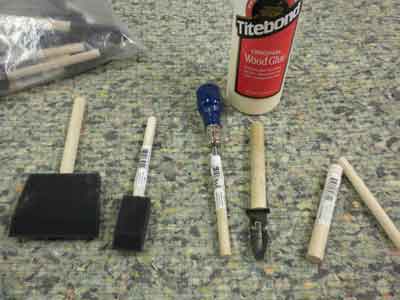
|
|
The life cycle of the common foam brush.
|
My friend, James, and I were enjoying a repast at church one Wednesday night as he extolled the virtues of the lowly foam brush. “The best thing about them is that they do an excellent job, then you throw them away!” Alas, I had to agree with my good friend on the former, but disagree on the latter. Sponge brushes do have their place in some finishing jobs, but I never throw them away the first time around. Paint washes out of them very easily if it isn’t dried. When they are no longer usable for painting, yank (pun intended) the sponge off and you have a wonderful plastic blade to spread anything from two-part epoxy to distributing wood glue inside biscuit slots.
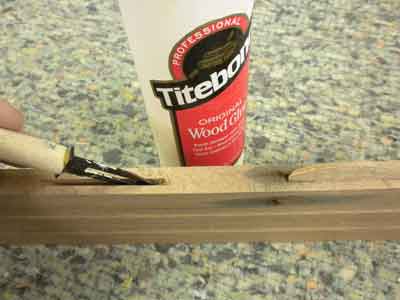
|
|
Run a bead of glue along the edge and down into the biscuit hole, then spread it evenly with the blade of the disposable brush.
|
The blade on a used-up sponge brush fits perfectly to spread glue in a biscuit slot. Heck, you could even spread butter on your biscuits with it! Then, when you can’t get any more good out of the blade, twist if off and you have a handy dowel with a million uses.
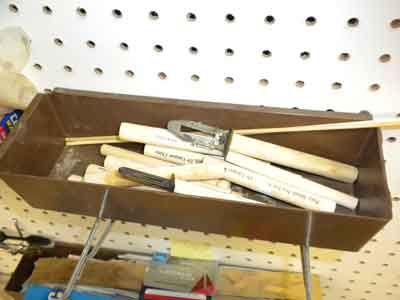
|
|
Leftover sponge applicator handles don’t take up much room and they are handy for lots of uses.
|
Of course, there’s always that final use: kindling in the shop’s wood stove.
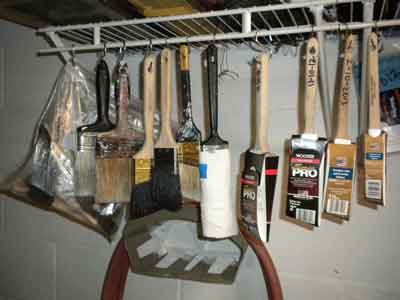
|
|
Paint brushes are a proud bunch. Here, you see how they have ordered the foam brushes to the caboose.
|
Jim Randolph is a veterinarian in Long Beach, Mississippi. His earlier careers as lawn mower, dairy farmer, automobile mechanic, microwave communications electronics instructor and journeyman carpenter all influence his approach to woodworking. His favorite projects are furniture built for his wife, Brenda, and for their children and grandchildren. His and Brenda's home, nicknamed Sticks-In-The-Mud, is built on pilings (sticks) near the wetlands (mud) on a bayou off Jourdan River. His shop is in the lower level of their home. Questions and comments on woodworking may be sent to
DrRandolph@MyPetsDoctor.com
. Questions about pet care should be directed to his blog on pet care,
www.MyPetsDoctor.com
. We regret that, because of high volume, not all inquiries can be answered personally.
Return to
Wood News
front page


